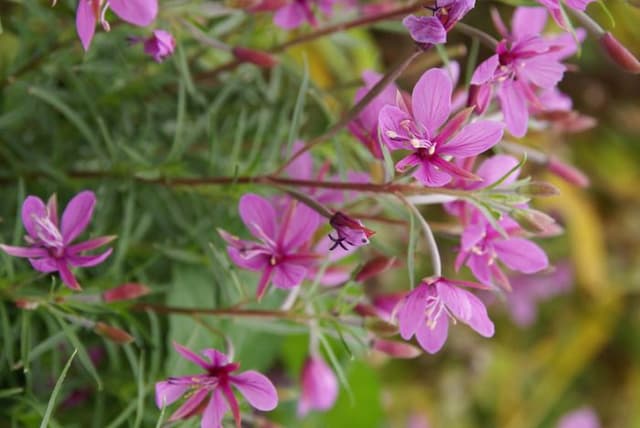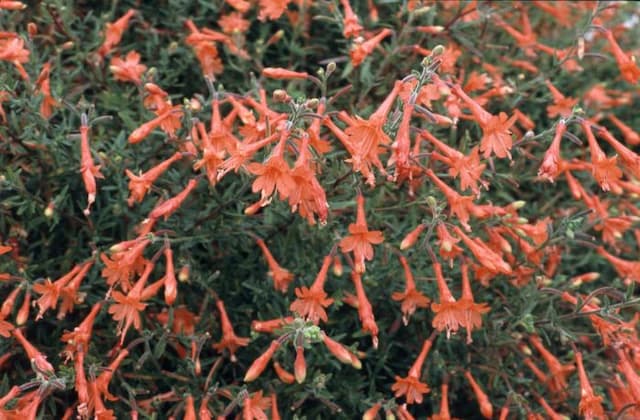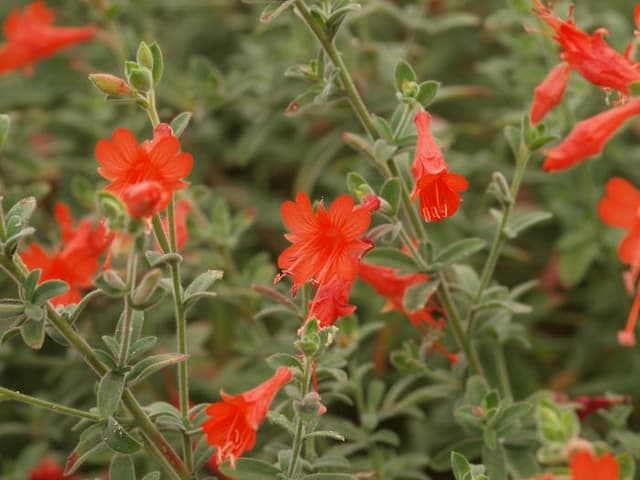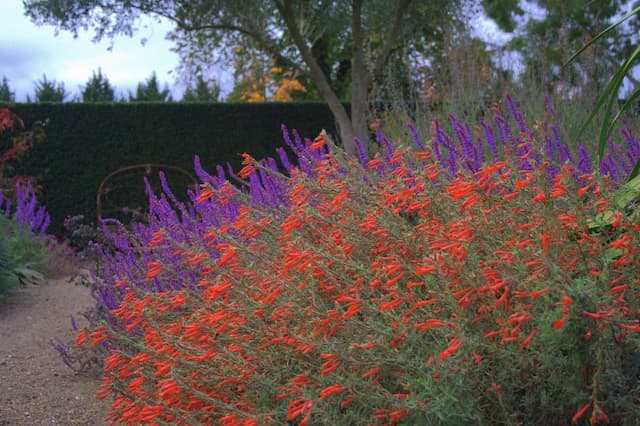Fuchsia 'Grayrigg'

ABOUT
Fuchsia 'Grayrigg' is a beautifully ornamental plant known for its distinctive and elegant flowers. The blooms dangle from the branches like delicate ornaments, showing off their exquisite coloration. The flowers have a two-toned appearance, typically featuring a deep pink to purple outer layer that gracefully curves back, revealing a softer, paler inner layer often in shades of pink, purple or white. The stamens hang below the petals, adding to the intricate display with their slender form and contrasting tips. The foliage of Fuchsia 'Grayrigg' is equally attractive, with leaves that have a lush, green hue. The leaves may have a slight glossy sheen to them and are oval-shaped with a gently serrated edge. Their arrangement on the branches is such that they offer a full, bushy backdrop to the striking flowers, enhancing the overall appeal of the plant. Over time, the branches of Fuchsia 'Grayrigg' can become somewhat woody, providing firm support for the profuse blooms and foliage. Its growth habit makes it a popular choice for hanging baskets and containers where its trailing stems and flowers can be showcased to dramatic effect. The drooping flowers provide a continuous display of beauty throughout its blooming season, enticing onlookers with their intricate form and vivid coloring.
About this plant
 Names
NamesFamily
Onagraceae
Synonyms
Lady's Eardrops, Fairy Bells, Fuchsia
Common names
Fuchsia 'Grayrigg'.
 Toxicity
ToxicityTo humans
Fuchsia is generally considered non-toxic to humans. However, like with any plant, individuals might have varying sensitivities and reactions to it. It’s always advisable to avoid ingesting plants that are not commonly recognized as food, as they may cause unintended reactions such as gastrointestinal discomfort. There are no well-documented cases of poisoning from Fuchsia in humans, so significant toxicity is unlikely.
To pets
Fuchsia plants are also considered non-toxic to pets, including cats and dogs. They should not cause harm if ingested by pets, but it is always best to discourage animals from chewing on non-food plants as it can sometimes lead to mild gastrointestinal upset simply from the plant material itself. As with any non-food item, excessive consumption could lead to other issues, such as intestinal blockages. However, fuchsias are not known for severe toxicity in pets.
 Characteristics
CharacteristicsLife cycle
Perennials
Foliage type
Deciduous
Color of leaves
Green
Flower color
Mixed
Height
1-2 feet (30-60 cm)
Spread
1-2 feet (30-60 cm)
Plant type
Shrub
Hardiness zones
9
Native area
Central and South America
Benefits
 General Benefits
General Benefits- Aesthetic Appeal: Fuchsia 'Grayrigg' boasts exquisite pendulous flowers that come in striking color combinations, adding visual interest to gardens and landscapes.
- Attracts Pollinators: The brightly colored blooms are attractive to hummingbirds and butterflies, encouraging biodiversity.
- Versatility: This plant can be grown in containers, hanging baskets, or garden beds, offering flexibility in landscaping and gardening.
- Shade Tolerance: Fuchsias, including 'Grayrigg', can thrive in partially shaded environments where other flowering plants might struggle.
- Long Flowering Period: Fuchsia 'Grayrigg' typically has a long blooming season, providing flowers from late spring through fall for extended enjoyment.
- Easy Propagation: It can be easily propagated from cuttings, allowing gardeners to create more plants for use in other areas or to share with friends.
 Medical Properties
Medical PropertiesThis plant is not used for medical purposes.
 Air-purifying Qualities
Air-purifying QualitiesThis plant is not specifically known for air purifying qualities.
 Other Uses
Other Uses- Fuchsia 'Grayrigg' can be used in fairy gardens due to its delicate and cascading flowers that provide a whimsical touch to miniature landscapes.
- The plant's unique flowers can be used for photographic subjects in macro photography, showcasing their intricate structures and vibrant colors.
- It can be applied as a natural dye for fabrics and materials, where the flowers provide subtle hues for artistic textile creations.
- Fuchsia can be utilized in educational settings as a tool for teaching botany and horticulture, through propagation and growth observation activities.
- The bushy growth habit of Fuchsia 'Grayrigg' makes it suitable for bonsai cultivation, which requires careful pruning and shaping of the plant.
- This plant can also be incorporated in traditional costumes or ceremonial attire as live adornments during performances or cultural events.
- Its blossoms can be used as edible decorations for desserts and cakes, giving an elegant and colorful touch to culinary presentations.
- In crafting, the vivid flowers offer inspiration for designs in embroidery, quilting, or fabric patterns.
- Water extracted from the leaves may be used as a scented rinse or mild cleaner for delicate surfaces, due to its gentle properties.
- Fuchsia 'Grayrigg' can be planted to create a living curtain or privacy screen on balconies or in small garden spaces.
Interesting Facts
 Feng Shui
Feng ShuiThe Fuchsia is not used in Feng Shui practice.
 Zodiac Sign Compitability
Zodiac Sign CompitabilityThe Fuchsia is not used in astrology practice.
 Plant Symbolism
Plant Symbolism- Confidence: Fuchsia's distinctive and vivid flowers symbolize confidence, representing boldness and individuality.
- Elegance: The graceful hanging blossoms of the Fuchsia plant are often viewed as a symbol of tastefulness, refinement, and good taste.
- Harmony: With its blend of two contrasting colors, the Fuchsia is seen as a representation of balance and harmony, suggesting a blend of opposites in unity.
- Amiability: The inviting and appealing appearance of Fuchsias make them a symbol of friendliness and kind-heartedness.
- Emotional openness: The open and prolific blooms of the Fuchsia advocate for an openness to emotions and communication.
 Water
WaterFuchsias, including the 'Grayrigg' variety, require consistent moisture and should be watered whenever the top inch of soil feels dry to the touch. In general, this may mean watering approximately once or twice a week, but the frequency will vary depending on climate, humidity, and indoor conditions. A good method is to water deeply, allowing excess water to drain away, which can equate to providing one to two gallons of water every week during the growing season. Reduce the amount during winter when the plant is not actively growing.
 Light
LightFuchsia 'Grayrigg' thrives in bright, indirect light with protection from harsh midday sun, which can scorch its delicate leaves. A spot that receives morning sunlight and afternoon shade is ideal, or a location with filtered light, such as behind a sheer curtain. Good lighting conditions in an east or north-facing window or a shaded southern exposure can provide the optimal environment for this plant to flourish.
 Temperature
TemperatureFuchsia 'Grayrigg' prefers a cool climate and performs best in temperatures ranging between 60 to 70 degrees Fahrenheit during the day and cooler at night, around 50 to 60 degrees Fahrenheit. Avoid exposing the plant to temperatures below 35 degrees Fahrenheit, as it is not frost-tolerant. During the winter months, it's important to protect fuchsias from cold drafts and freezing temperatures to ensure healthy growth.
 Pruning
PruningPruning fuchsia 'Grayrigg' is essential for maintaining a compact, bushy shape and encouraging prolific blooming. Trim back the tips of branches in the spring to promote branching, and after flowering, cut back spent flower stems to encourage more blooms. Pruning should be done at least once a year, but periodic pinching during the growing season can be beneficial.
 Cleaning
CleaningAs needed
 Soil
SoilThe Fuchsia 'Grayrigg', commonly known as the fuchsia, thrives in a soil mix that is rich, moist, and well-drained with a pH of about 6.0 to 7.0. A good recipe for the fuchsia soil mix is to combine one part peat moss, one part loam, and one part perlite or coarse sand to ensure proper drainage and aeration.
 Repotting
RepottingFuchsias, including the 'Grayrigg' variety, should be repotted annually, typically in the spring. This is to refresh the soil and to accommodate the plant's growth by moving it to a slightly larger pot if necessary.
 Humidity & Misting
Humidity & MistingThe fuchsia 'Grayrigg' prefers a relatively high humidity level, ideally ranging between 60% to 70%. To maintain optimal humidity, mist the foliage regularly or place a humidity tray beneath the pot.
 Suitable locations
Suitable locationsIndoor
Place fuchsia 'Grayrigg' in bright, indirect light and maintain high humidity.
Outdoor
Grow fuchsia 'Grayrigg' in part shade, sheltered from strong winds.
Hardiness zone
9-11 USDA
 Life cycle
Life cycleFuchsia 'Grayrigg' begins its lifecycle with seed germination, typically occurring in a moist and warm environment, where the seeds will sprout and develop into seedlings. Once the seedlings establish themselves, they grow into young plants, developing a root system and foliage, as they undergo vegetative growth. As the plant matures, it enters the flowering stage, producing distinctive pendant-shaped flowers, often in shades of pink, purple, and white, which attract pollinators. After pollination, the flowers form berries that contain seeds, marking the plant's reproductive phase. If conditions allow, these seeds will fall to the ground and potentially germinate, beginning a new life cycle. Throughout the growing season, fuchsia 'Grayrigg' may undergo pruning to encourage bushier growth and more prolific flowering, and in colder climates, it requires protection or indoor overwintering to survive and continue its life cycle the following year.
 Propogation
PropogationPropogation time
Spring-Early Summer
Fuchsia 'Grayrigg', commonly known as fuchsia, is often propagated through softwood cuttings. The best time for taking softwood cuttings for propagation is late spring to early summer when the growth is new and green. To propagate by this method, a cutting of about 2 to 4 inches (5 to 10 cm) long with a couple of leaves is snipped just below a leaf joint. The lower leaves are removed, and the base of the cutting is dipped in rooting hormone before being planted in a moist potting mix. The pot with the cutting should be placed in a warm area with indirect sunlight and covered with a plastic bag to maintain humidity. Roots typically develop within three to four weeks, after which the new fuchsia plant can be transplanted into a larger pot or the garden.









